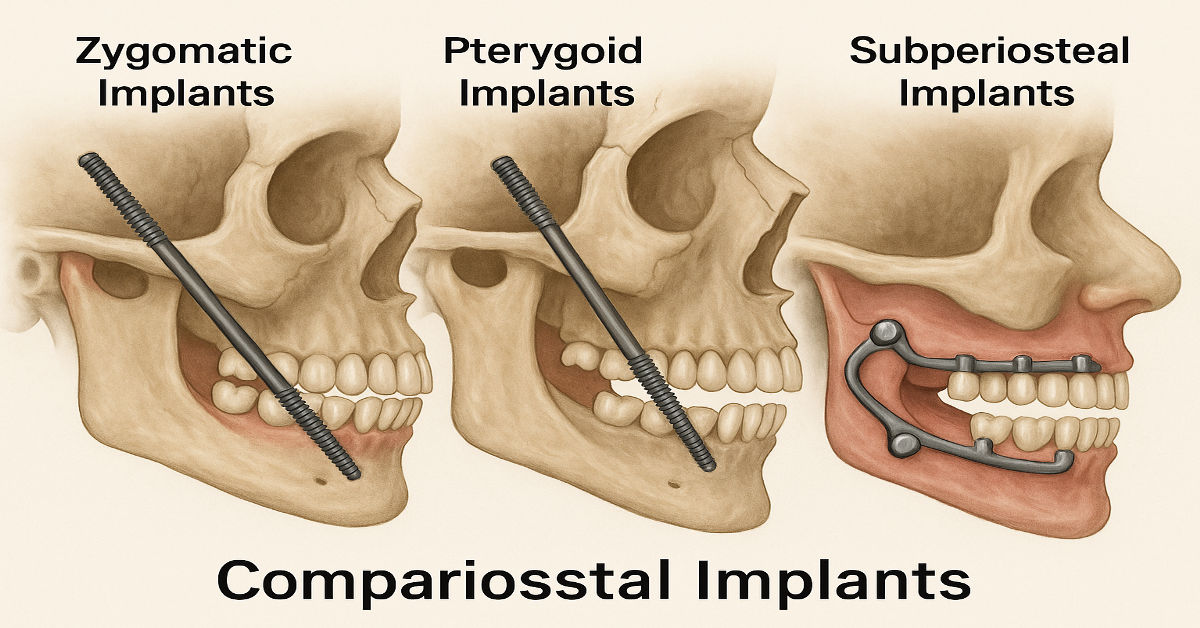It is no secret that dental implants have completely revolutionised the field of restorative dentistry, offering a safe and durable solution for patients with missing teeth. Unlike traditional dentures or bridges, dental implants provide a comfortable, permanent, and stable foundation by integrating directly with the jawbone and closely mimicking the function of natural tooth roots. This not only restores the aesthetics of a full, confident smile but also preserves the strength and shape of the jawbone, preventing bone loss that occurs as a natural consequence of tooth loss. With their ability to support single crowns, bridges, or even full-arch restorations, dental implants have truly changed the game and are now hailed as the ‘gold’ standard for tooth replacement for all the right reasons. However, not all dental implants are made the same. Among the various types available are zygomatic, pterygoid, and subperiosteal implants, which we will discuss in detail today as each of them is unique in its design and application. What they all have in common is that they are used in cases with insufficient bone, usually in the upper jaw, to support traditional implants.
Dental Implants: A Saviour for Severe Bone Loss
After tooth loss or the onset of periodontal disease (gum disease), the jawbone begins to experience a degenerative process known as bone resorption, where it gradually loses bone mass and density. This occurs because the bone naturally relies on the stimulation from chewing and biting forces transmitted through the teeth to maintain its strength and structure. When a tooth is lost, the area of the bone that once supported the tooth no longer receives this essential stimulation, leading to a decrease in bone density over time. Periodontal disease can also exacerbate this issue by causing the bone and soft tissue surrounding and supporting the teeth to break down. As the disease progresses, it can lead to significant bone loss, compromising the stability of remaining teeth and altering the facial structure. If left unaddressed, these conditions can result in further tooth and bone loss and, consequently, difficulty inserting dental implants into the jawbone for tooth replacement.
The pterygoid and zygomatic implants are anchored into the pterygoid and zygomatic bones of the face, which do not undergo the natural process of bone resorption over time when one starts to lose teeth or as a result of gum disease, unlike the maxilla. This means these areas can better support and retain implants in cases where the maxillary bone (upper jawbone) is deficient.
Subperiosteal dental implants are a specialised type of dental implant designed for patients who lack sufficient bone density in their jaw to support traditional implants. Unlike conventional implants, which are inserted directly into the jawbone, subperiosteal implants rest on top of it underneath the gum tissue. These implants consist of a custom-made metal framework that conforms to the shape of the jawbone, with posts protruding through the gums to hold the prosthetic (artificial) teeth in place. Subperiosteal implants are particularly beneficial for those who cannot undergo bone grafting procedures or more invasive implant surgeries to augment the bone and thus offer a viable alternative to restore oral function and aesthetics. They do, however, come with a few downsides. For instance, they typically offer slightly lower stability and may require more frequent adjustments than the other types of implants. Previously, subperiosteal implants were associated with severe complications such as implant exposure, implant mobility, and implant loss. However, thanks to the recent digital revolution that has taken place in dentistry, new digital techniques for acquisition, improved processing software, and modern fabrication techniques have enabled the beginning of a new era in fixed prosthodontics, including the customisation of implant therapy, allowing for improved treatment outcomes and prevention of potential complications.
Understanding the differences between these implants is crucial for determining the most suitable option for each individual case. In this blog, we’ll explore the key differences between zygomatic, pterygoid, and subperiosteal implants in terms of shape, location, surgical procedure, bone density requirements, stability, and cost.
1. Shape and Design
Zygomatic Implants: Zygomatic implants are significantly longer than traditional implants, with lengths reaching up to 52.5mm. They are designed to anchor into the zygomatic bone (in the cheekbone area), which provides a stable foundation even in cases where the upper jawbone is insufficient. Their extra-long length and shape allow them to bypass the upper jaw entirely, extending directly into the zygomatic bone.
Pterygoid Implants: Pterygoid implants are also longer than standard implants but not as long as zygomatic ones, typically ranging between 15mm to 25mm. These implants are designed to engage the pterygoid plate, a portion of the sphenoid bone located behind the upper jaw. Their design allows them to access the dense bone in this region, providing support for dental restorations without undergoing additional bone augmentation procedures, like bone grafting.
Subperiosteal Implants: Subperiosteal implants have a completely different design compared to zygomatic and pterygoid implants. Instead of being inserted into the bone, they are placed on top of it, underneath the periosteum (the layer of soft tissue covering the bone). This type of implant has a custom-made metal framework that conforms to the shape of the bone as it rests over it, with posts that protrude through the gums to hold the prosthetic teeth in place in the mouth.
2. Location of Placement
Zygomatic Implants: These implants are placed in the zygomatic bone, a dense and strong part of the upper jaw bone located near the cheek area. The zygomatic bone offers a reliable anchor for the implant, especially in cases where the upper jawbone has deteriorated due to factors such as tooth loss or aging, as it forms the most prominent portion of the face.
Zygomatic implants can only be placed in the upper jaw.
Pterygoid Implants: The pterygoid implant is fixed into the Pterygoid process of the sphenoid bone, a bone located at the base of the skull, behind the maxillary (upper jaw) bone. This placement allows the implant to secure a stable base in dense bone tissue that is often preserved even when the maxillary bone is compromised.
Pterygoid implants can be given in both the upper and lower jaws.
Subperiosteal Implants: Subperiosteal implants are placed on top of the jawbone, under the gum tissue, without penetrating the bone like zygomatic or pterygoid implants. This makes them ideal for patients with insufficient bone mass in the upper or lower jaws and for whom traditional implants or even zygomatic and pterygoid implants are not feasible.
Subperiosteal implants can be used both in the upper and lower jaws.
3. Surgical Procedure
Zygomatic Implants: The placement of zygomatic implants is a complex surgical procedure, typically performed under general anesthesia or IV sedation. The surgeon begins by making an incision in the gum tissue to expose the bone and then drills into the zygomatic bone to place the implant. Due to the proximity of this area to the sinus cavity, a nearby structure, this procedure is highly technique-sensitive. It thus requires exceptional skill and expertise on the part of the surgeon.
Pterygoid Implants: Pterygoid implant placement is also a technically demanding procedure. It involves making an incision in the gum to expose the pterygoid region and carefully inserting the implant into the pterygoid bone. This procedure often requires advanced imaging techniques to ensure precise placement due to the proximity of the dental implant to critical anatomical structures.
Subperiosteal Implants: Subperiosteal implant placement involves creating a detailed impression or digital scan of the jawbone to fabricate a custom metal framework. The surgeon then makes an incision to expose the bone and fits the metal frame over the jawbone with small titanium screws that penetrate slightly into the densest areas of the bone. Posts are then attached to the frame, which protrude through the gum, onto which the dental prosthesis, such as crowns or a denture, is attached.
4. Bone Density and Requirements
Zygomatic Implants: Zygomatic implants are ideal for patients with severe maxillary bone loss since they do not rely on the upper jawbone for support. The zygomatic bone (cheekbone) typically has sufficient density to support these implants, circumventing the need for additional bone augmentation procedures like bone grafting.
Pterygoid Implants:
The pterygoid region is located at the back of the upper jaw, near the base of the skull. Specifically, this area involves the pterygoid plates, which are part of the sphenoid bone—a complex bone that forms the base of the skull behind the nasal cavity. The pterygoid plates are positioned towards the back of the maxilla (upper jaw), close to the junction with the nasal cavity and the palatine bone.
Replacing missing teeth in the back of the maxilla (upper jaw bone) is always challenging for the treating implant surgeon as this area poses some hindrances to the placement of dental implants. These issues present as deficiencies in quality, quantity, and the anatomy of the nearby structures, such as the maxillary sinus. Accessing this area is no easy feat either. Several surgical procedures have been tried over the years to overcome these inherent problems, such as sinus lift and bone augmentation and using tilted, short, and zygomatic implants. However, all these procedures come with limitations of their own. To overcome these problems, the pterygomaxillary region was chosen as an alternative implant placement site. Luckily, this site turned out to be a saviour and provided us with an excellent place for the placement of implants and rehabilitation of the posterior maxilla.
Pterygoid implants are positioned into the dense bone of the pterygoid plates. The implant is inserted in the bone at an angle to provide maximum stability. This location offers a stable and strong foundation for the dental implant, making it an excellent tooth replacement option for patients who lack sufficient bone density in the upper jaw, eliminating the need to undergo bone augmentation procedures.
Subperiosteal Implants: Subperiosteal implants are used in cases where there is a slightly lower bone density present than that required for traditional implants. Since these implants rest on top of the bone rather than being inserted into it, bone density is less of a concern when considering this restorative option.
5. Stability and Success Rates
Zygomatic Implants: Zygomatic implants offer high stability due to their direct anchorage in the zygomatic bone, a much stronger and denser area of the jawbone. They have a high success rate, especially when the implant procedure is performed by an experienced oral surgeon, and are known for their long-term reliability.
According to 2022 research, the success rate of zygomatic implants used in cases of severe bone loss was in the high nineties, with a cumulative success rate of 96.1% after more than five years.
Pterygoid Implants: Pterygoid implants also provide excellent stability, anchored in dense bone tissue of the pterygoid region. Success rates are high, comparable to zygomatic implants, and have similar longevity when placed correctly.
Subperiosteal Implants: Subperiosteal implants generally have lower stability compared to zygomatic and pterygoid implants as they do not penetrate the bone and instead rely on the strength of the surrounding gum tissue and jaw bone to hold and support the artificial teeth. Success rates are consequently lower for these implants, too, and they may require more maintenance and adjustments over time. However, thanks to the advances in digital technology, they remain a viable option for patients who cannot undergo other types of implant surgery.
6. Cost Considerations
Zygomatic Implants: Zygomatic implants are among the most expensive dental implant options due to the complexity of the procedure, the expertise and specialised equipment required, and the longer implant length. The cost can vary significantly depending on specific needs, such as the number of implants required for each case.
Pterygoid Implants: The cost of pterygoid implants is generally lower than that of zygomatic implants but still higher than standard implants due to the specialised nature of the procedure. The number of implants needed and the surgeon’s expertise can also affect the overall cost.
Subperiosteal Implants: Subperiosteal implants are typically more affordable than zygomatic and pterygoid implants, though still costlier than standard implants. The custom fabrication of the metal framework adds to the expense, but as the procedure is minimally invasive, the total costs of bone grafting or extensive surgery are reduced.
As opposed to the other two types of implants, the success of a subperiosteal implant majorly depends on good record-taking, treatment planning, and digitalisation of the records than on the implant technique.
Conclusion
Choosing the right type of dental implant depends on various factors, including bone density, the extent of bone loss, and patient-specific anatomical considerations. Zygomatic implants offer a practical solution for patients with severe upper jawbone loss, anchoring into the zygomatic bone and providing excellent stability.
Pterygoid implants, on the other hand, serve as an alternative for those with inadequate maxillary bone but sufficient density in the pterygoid region. For patients with minimal bone availability or those unable to undergo extensive surgical procedures, subperiosteal implants provide a less invasive option, though they may offer slightly lower stability and success rates.
Ultimately, the choice between these implants should be made in consultation with a skilled oral surgeon, who can assess the individual needs, create tailored treatment plans, and ensure the best possible outcome. At Zental, we treat each case with the utmost care and attention to detail, always going the extra mile to guarantee excellent patient results. If you have any questions about dental implants or would like to schedule a consultation, please do not hesitate to contact us.







